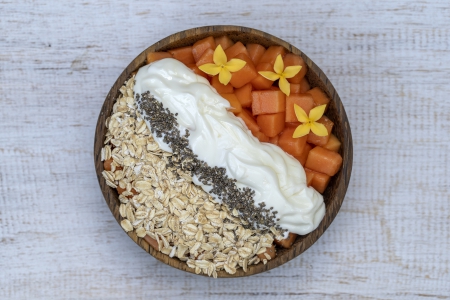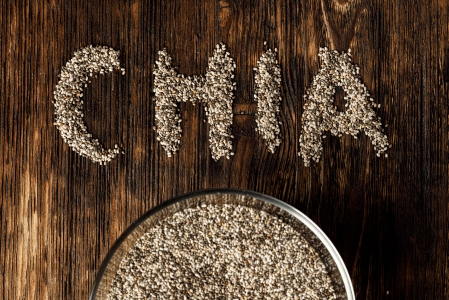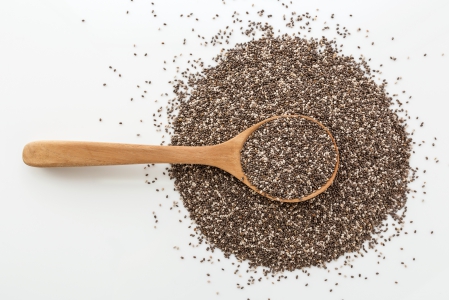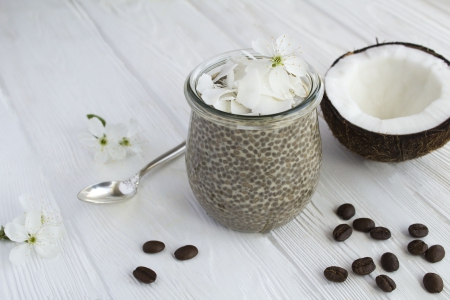Chia seed is an important nutritious and edible seed belongs to sage family. It is packed with various essential nutrients and should be consumed in regular diet for improving overall nutritional status.
Characteristics
- It is oval shaped small seed
- It weighs about 1.3 mg
- It is mottle colored with white, grey and black
- It has a nutty flavor
Nutritional overview
- It contains desirable amount of carbohydrates
- It is significantly rich in fibre
- It also contains significant amount of proteins and considered as a good source of proteins as it contains several amino acids at adequate proportion
- It contains polyunsaturated fatty acid especially rich in omega-3 and omega-6 fatty acid
- It contains saturated fatty acid and Trans fatty acid in negligible amount but totally free from cholesterol
- It is packed with numerous micronutrients such as calcium, phosphorus, iron, manganese, copper, zinc, selenium, magnesium, Vitamin A and Vitamin C
- It contains various biologically active compounds, which have great health importance that include chlorogenic acid, quercetin, caffeic acid and kaempferol
Biological properties
Antioxidant activities

- It is filled with numerous antioxidants that help to protect the body from oxidative damages
- It helps to prevent lipid peroxidation (oxidative degradation of fat molecules) hence reduces the susceptibility of developing cytotoxicity
- It helps to decrease free radicals’ concentration within body by scavenging them and hence reduces oxidative stress
- It also spares various important biological substances of body (like proteins, DNA, RNA) from oxidative damages
- It is associated with inhibiting the oxidative degradation of phospholipids of cell membrane and promotes cellular transport by maintaining membrane function
Anti-carcinogenic effects
- Its unsaturated fatty acid content and antioxidant activities are accountable for reducing the risk of cancers
- It helps to suppress cancerous cell growth by regulating apoptosis and cell proliferation
- It also prevents metastasis
- Its lignan component is responsible for inhibiting the cellular growth of breast tumor
Anti-inflammatory activities
- It helps to prevent inflammation by reducing the concentration of inflammatory markers within body
- It plays significant role in reducing the level of CRP. It has seen that consumption of chia seed is associated with decreasing the CRP concentration up to 40%
- It also helps to prevent swelling and pain
- Its protein content, fibre content and fatty acid content (especially alpha linolenic acid) also influence the anti-inflammatory activities of chia seed

Health benefits
Role on nervous system
- It is related with improving the functionality of both peripheral and central nervous system
- Its ALA component is responsible for improving concentration, memory and cognitive abilities
- It helps to improve learning skills among children of ADHD (Attention deficit hyperactivity disorder)
- It also helps to improve the symptoms of Alzheimer’s disease
Role on digestive health
- It helps in digestion and absorption
- Its fibre content is responsible for improving bowel health as it increases bowel movement and promotes regularity
- It also helps to improve colonic health by promoting peristalsis and by water absorption in colon that decreases the susceptibility of developing diverticular diseases
- It helps to decrease the colonic pressure as well
- It also helps to protect the gastrointestinal tract from inflammatory damages and hence reduces the prevalence of inflammatory bowel syndrome and ulcer formation
Role on skeletal system
- It plays significant role for improving bone health
- Its calcium, phosphorus, protein and magnesium contents are responsible for bone formation and mineralization
- It also helps to improve bone strength
- It helps to increase bone mass
- Its consumption is very beneficial for reducing bone disorders as it helps to reduce the prevalence of bone fractures and bone losses

Role on muscle
- Its protein contents act as an effective building block for muscle. It is very useful for promoting muscular growth and development
- It helps to increase muscle mass
- It is also associated with increasing muscular strength that stimulates the ability of the body for performing strenuous muscular activities and hence increases endurance
Role on detoxification
- It helps to eliminate toxins from body, which helps to make the body active and healthy
- It helps to improve hepatic function, which is related with promoting detoxification processes
Role on skin
- It helps to improve skin health
- Its antioxidant property is responsible for protecting the skin from oxidative damages that help to reduce the susceptibility of developing skin disorders
- It helps to treat acne
- It helps to prevent ageing
- Its omega-3-fatty acid content is responsible for improving skin glow
- It is also related with rapid healing of irritated blemish wounds
Medicinal usage
Effect on cholesterol level
- It is extensively used for reducing elevated lipid profile and helps to treat the consequences of hyperlipidemia
- It has seen that its fibre and unsaturated fatty acid contents play significant role for reducing serum cholesterol level
- It helps to decrease the level of LDL, VHDL and triglycerides. Whereas enhances HDL (good cholesterol) concentration
- It also helps to maintain the normal ratio of LDL and HDL that helps to decrease the prevalence of metabolic syndromes

Effect on cardiovascular system
- It acts as an effective therapeutic agent for preventing cardiovascular diseases
- It helps to protect the heart from oxidative damages
- Its lipid (especially LDL) lowering activity helps to reduce the susceptibility of developing atherosclerosis
- It also helps to reduce the prevalence of thrombosis and plaque formation within blood vessels that prevents the risk of developing coronary artery diseases, heart attacks and strokes
- It is related with improving endothelial function
- It also helps to prevent arrhythmia
- It helps to decrease hypertension that also promotes cardiac health
Hypoglycemic effect
- It is also used as an anti-diabetic agent as it helps to regulate blood sugar concentration
- It is associated with improving insulin sensitivity that reduces the prevalence of type 2 diabetes mellitus
- It also helps to stabilize blood sugar level
- Its fibre content also plays significant role for preventing hyperglycemia by reducing the rate of glucose absorption through intestine
- It has seen that consumption of chia seed is very beneficial for reducing fasting blood sugar level

Effect on weight management
- It helps in weight reduction by increasing the metabolic rate of the body
- Its fibre content is responsible for decreasing appetite as it provides a feeling of stomach fullness and hence helps to decrease food intake that influences the energy balance
- Its omega-3-fatty acid content also helps to promote weight reduction
- It is better to consume chia seed mixed with water (forma a gel like structure), as it digests slowly within body hence preventing hunger for a long period of time
Risk factors
- Consumption of chia seed is very beneficial for health, but its over consumption of causes various health hazards, which include –
- Nausea
- Diarrhea
- Vomiting
- Abdominal pain
- Gas formation
- Bloating
- As it is high in protein as well as in phosphate hence individual suffers from renal disorders should avoid it

Source:
Deka, R. and Das, A., 2017. Advances in chia seed research. Technology, 59(2), pp.1304-1310.
Grancieri, M., Martino, H.S.D. and Gonzalez de Mejia, E., 2019. Chia seed (Salvia hispanica L.) as a source of proteins and bioactive peptides with health benefits: A review. Comprehensive Reviews in Food Science and Food Safety, 18(2), pp.480-499.
Jaddu, S. and HV, Y., 2018. Chia seed: A magical medicine. J of Pharm Phyto, 7(2), pp.1320-1322.
Marcinek, K. and Krejpcio, Z., 2017. Chia seeds (Salvia hispanica): health promoting properties and therapeutic applications-a review. Roczniki Państwowego Zakładu Higieny, 68(2).
Orona-Tamayo, D., Valverde, M.E. and Paredes-Lopez, O., 2017. Chia—The New Golden Seed for the 21st Century: Nutraceutical Properties and Technological Uses. In Sustainable protein sources (pp. 265-281). Academic Press.
Parker, J., Schellenberger, A.N., Roe, A.L., Oketch-Rabah, H. and Calderón, A.I., 2018. Therapeutic perspectives on chia seed and its oil: a review. Planta medica, 84(09/10), pp.606-612.
Rendón-Villalobos, J.R., Ortíz-Sánchez, A. and Flores-Huicochea, E., 2018. Nutritionally Enhanced Foods Incorporating Chia Seed. In Therapeutic Foods (pp. 257-281). Academic Press.
Suri, S., Passi, S.J. and Goyat, J., 2016, March. Chia seed (Salvia hispanica L.)—A new age functional food. In 4th International Conference on Recent Innovations in Science Engineering and Management (pp. 286-299).




